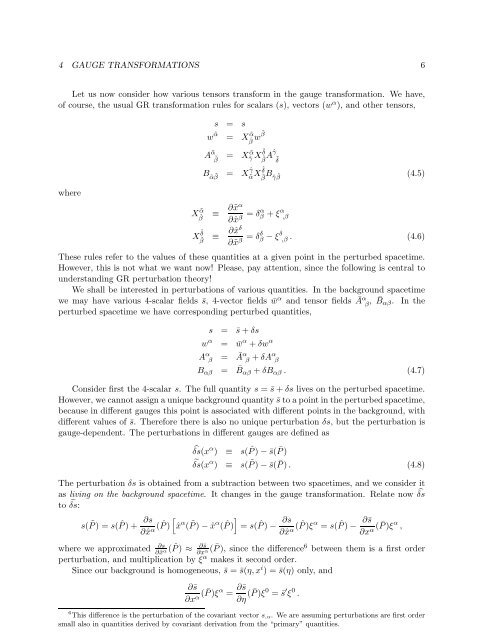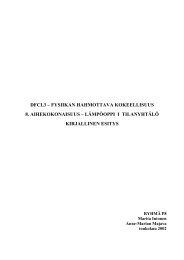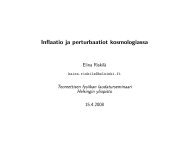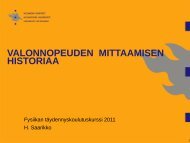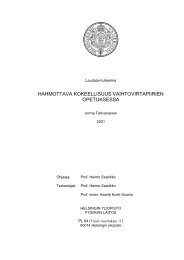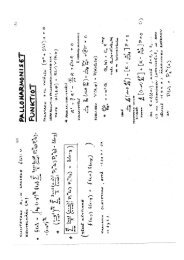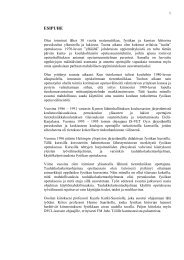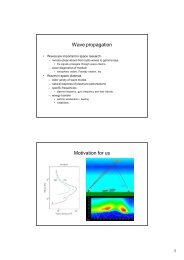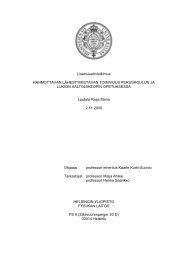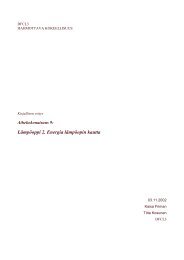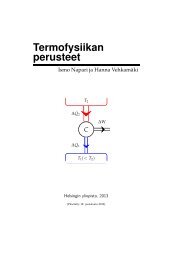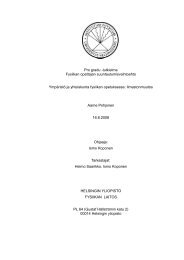Cosmological Perturbation Theory, 26.4.2011 version
Cosmological Perturbation Theory, 26.4.2011 version
Cosmological Perturbation Theory, 26.4.2011 version
Create successful ePaper yourself
Turn your PDF publications into a flip-book with our unique Google optimized e-Paper software.
4 GAUGE TRANSFORMATIONS 6Let us now consider how various tensors transform in the gauge transformation. We have,of course, the usual GR transformation rules for scalars (s), vectors (w α ), and other tensors,s = sw˜α = X ˜αˆβ w ˆβA˜α˜β= X ˜αˆγ Xˆδ˜βAˆγ˜δB˜α˜β= Xˆγ˜α Xˆδ˜βBˆγ ˆβ(4.5)whereX ˜αˆβXˆδ˜β≡≡∂˜xα∂ˆx β = δα β + ξα ,β∂ˆxδ∂˜x β = δδ β − ξδ ,β . (4.6)These rules refer to the values of these quantities at a given point in the perturbed spacetime.However, this is not what we want now! Please, pay attention, since the following is central tounderstanding GR perturbation theory!We shall be interested in perturbations of various quantities. In the background spacetimewe may have various 4-scalar fields ¯s, 4-vector fields ¯w α and tensor fields Āα β , ¯Bαβ . In theperturbed spacetime we have corresponding perturbed quantities,s = ¯s + δsw α = ¯w α + δw αA α β = Āα β + δAα βB αβ = ¯B αβ + δB αβ . (4.7)Consider first the 4-scalar s. The full quantity s = ¯s + δs lives on the perturbed spacetime.However, we cannot assign a unique background quantity ¯s to a point in the perturbed spacetime,because in different gauges this point is associated with different points in the background, withdifferent values of ¯s. Therefore there is also no unique perturbation δs, but the perturbation isgauge-dependent. The perturbations in different gauges are defined aŝδs(x α ) ≡ s( ˆP) − ¯s( ¯P)˜δs(x α ) ≡ s( ˜P) − ¯s( ¯P). (4.8)The perturbation δs is obtained from a subtraction between two spacetimes, and we consider itas living on the background spacetime. It changes in the gauge transformation. Relate now ̂δsto ˜δs:s( ˜P) = s( ˆP) + ∂s [∂ˆx α( ˆP) ˆx α ( ˜P) − ˆx α ( ˆP)]= s( ˆP) − ∂s∂ˆx α( ˆP)ξ α = s( ˆP) − ∂¯s∂x α( ¯P)ξ α ,where we approximated ∂s∂ˆx( ˆP) ≈∂¯sα ∂x( ¯P), since the difference 6 between them is a first orderαperturbation, and multiplication by ξ α makes it second order.Since our background is homogeneous, ¯s = ¯s(η,x i ) = ¯s(η) only, and∂¯s∂x α( ¯P)ξ α = ∂¯s∂η ( ¯P)ξ 0 = ¯s ′ ξ 0 .6 This difference is the perturbation of the covariant vector s ,α. We are assuming perturbations are first ordersmall also in quantities derived by covariant derivation from the “primary” quantities.


